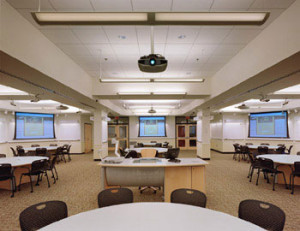The Ultimate Active Learning Space: The TEAL Classroom
on Thursday, 20 November 2014.
The Technology Enabled Active Learning (TEAL) classroom was developed more than 10 years ago at MIT to enhance learning and engagement and increase attendance and success of first and second year physics students. It completely changes the design, layout, technology and pedagogy used in the room and courses.
TEAL classroom instructors focus class time on collaborative and practical application exercises. The room is designed as if there is no front or back of the room; round work tables are placed along the outside walls of the room. The instructor’s desk is in the middle of the room and white boards and displays (or projectors and screens) are situated on the outside walls next to the round work tables. Each station has connectivity for laptops or tablets and cameras for capture are dispersed throughout the room. This layout allows smaller groups of students to work together on course curriculum and help each other through problem solving and comprehension. The technology and connectivity offers immediate research opportunities, sharing information between students and instructor and faculty guidance.
The format of these classes require re-evaluation, changing from lecture only to active learning. The students help to determine the pace they move through the course material. The challenge here is covering the breadth of material in the allotted course hours. The TEAL classrooms and improved pedagogy have significantly reduced the number of physics students who have to re-take their first or second year course. Instructors also report that the students seem to be learning the content more comprehensively with more practical understanding than in traditional lecture room setups. It has been so successful among science and engineering students that many US colleges and universities have designed and installed TEAL rooms and developed their own course curriculum for active learning.
The furniture and technology integration is imperative to the successful rollout of these TEAL rooms. Products like FSR’s HuddleVU and HuddleVU Flex can help to incorporate the collaborative connectivity needed for active learning and engagement. Remember that furniture placement, room design and ease interaction with technology must be primary considerations.
Have you designed active learning spaces for your school? Has it been successful? What are the challenges? Share your feedback here!
